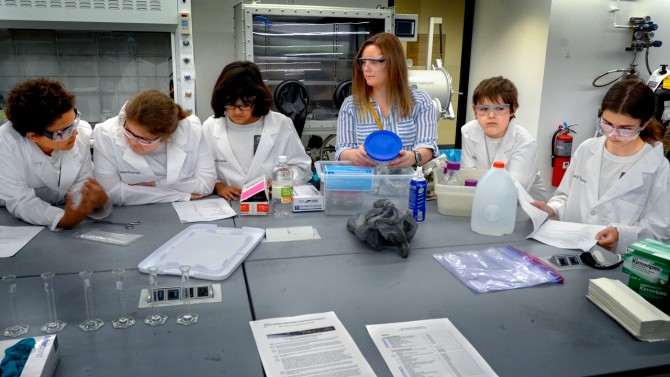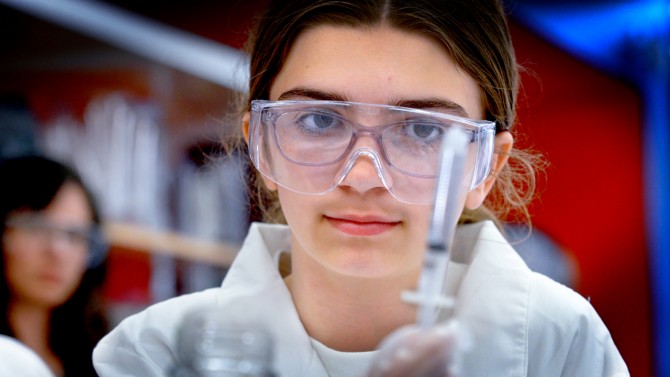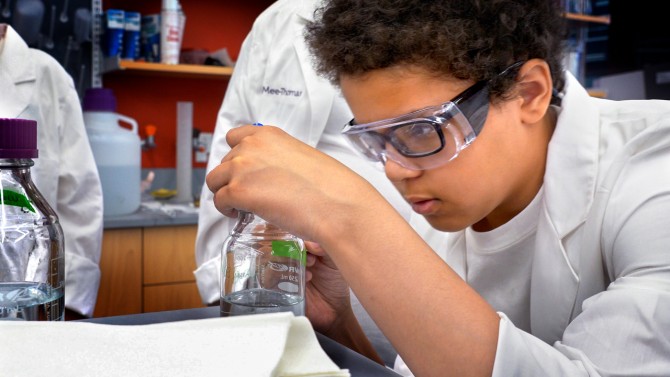Five middle school students with the Cornell Cooperative Extension of Jefferson County's 4-H Youth Development Program in Watertown, N.Y., assemble an experiment for the International Space Station.
4-H’ers prepare ‘rusty’ experiment for space station
By Blaine Friedlander
Five students from Watertown’s H.T. Wiley Intermediate School 4-H after-school program will watch their experiment soar from Cape Canaveral, Florida, July 21 toward the heavens on a SpaceX Falcon 9 rocket. Destination: the International Space Station.
The students proposed and built their experiment encouraged and inspired by Jefferson County Cornell Cooperative Extension, in consultation with chemical engineering faculty at Cornell. The students’ experiment focuses on the efficacy of removing metallic rust in the microgravity of space.
“My favorite thing was testing the actual experiment,” said Agnika Ghatak, a rising seventh grader. “It’s exciting. It’s a great feeling of accomplishment that our team worked so hard for getting this experiment to go into space.”
While the midsummer launch is a highlight, about 250 students – in 11 Jefferson County, New York, schools – started this space journey in early September 2018. They conducted research and developed experiment proposals working through the Jefferson County Cornell Cooperative Extension’s 4-H Youth Development after-school program.
About 50 student-teams initiated spaceflight-experiment ideas that ranged from the potency of hand sanitizer in space to microgravity’s effect on carbon steel to understanding bacterial growth in a space station setting.
All of the Jefferson County 4-H after-school youth participated in the Students Spaceflight Experiments Program, which is part of the National Center for Earth and Space Science Education (NCESSE). The program aims to inspire the next generation of America’s scientists and engineers, and the prize is getting to send an experiment to space.
Mallary Williams, Ryan Arca-Steel, Skyye Mee-Thomas, Alex Higginbotham and Agnika Ghatak formed a team in Ann Fillhart’s sixth grade class – they’re seventh graders now – about a year ago. Inspired by their after-school instructor Skyler Rizzo, Jefferson County CCE after-school coordinator – who piqued interest by talking about the “vomit comet,” the jetliner used to train astronauts in weightlessness and other kid-friendly science topics – the students gathered in the school library and dove into books to learn about rust.
Fillhart explained that Mallary Williams had first suggested rust for an experiment, and soon the student team was fascinated by it. “They decided to make the rust here on Earth and then see how rust was removed in microgravity,” she said.
Kathy Vaeth ‘94, senior lecturer in Cornell’s Smith School of Chemical and Biomolecular Engineering, invited the Watertown students to assemble the experiment – under the supervision of Julia Hoskins, internal payloads mission manager at NanoRacks, the group that ensures space-bound material meets space station guidelines – at a chemistry lab in Olin Hall on June 28. Chemical engineering major Ann Metzloff ’21 and Vaeth were on hand to help guide the students.
Using a fluid-mixing enclosure device – a thick, flexible plastic test tube, about the size of a regular hot dog – small, prerusted iron pins were placed in the center. Earlier, the pins were precisely machined at New York Air Brake and were expertly rusted at Knowlton Technologies, both Watertown companies.
Students placed distilled vinegar on one side of the experiment chamber and distilled water on the other. When astronauts unclamp the vinegar side, it will remove the rust; three days later, the astronauts will unclamp the distilled water, which will neutralize the vinegar. In late August the experiment will be returned to Earth, and the students will report the results.
Mitch McCormick, CCE Jefferson County director of the 4-H after-school programs, said that judging panels and NCESSE officials were impressed with the rust experiment, saying it may create useful knowledge for future space missions. “We try to deliver research-based education and programming,” McCormick said. “This is the first 4-H program to send an experiment to space.”
Dan Mincer ’01, who graduated from Cornell in natural resources, now the assistant principal at Wiley Intermediate School, was so proud for his students, he bought them lab coats embroidered with their names.
Fillhart, McCormick and Mincer will chaperone the students to Cape Canaveral for the launch.
Media Contact
Get Cornell news delivered right to your inbox.
Subscribe



